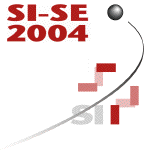


|
|
Abstracts
|
Eclipse - Evolving
towards a general component platform By now Eclipse (www.eclipse.org) is well known as an open source project dedicated to provide a robust platform for developing highly integrated tools. Eclipse is currently expanding its scope to become a general platform upon which anybody can add software components to build end user applications. This is enabled by a scalable plug-in architecture which supports controlled extensibility. To support dynamic plug-ins and to provide more configurability Eclipse 3.0 is migrating to an OSGi based run-time system. This talk provides an overview of the Eclipse plug-in architecture and its most recent evolution.
Business process
integration using UML and BPEL4WS The emergence of the 'Model to Integrate' theme as a means to provide business process integration is well underway. This session will shows how architects and developers can use models and metadata to enable business integration. The talk will conclude with an overview of the standardizion efforts underway at OASIS and OMG on business process integration.
Components and their
proofs More than ever today, building reusable components is the "Future of Software Engineering"; in fact, there's arguably no other in sight. The only components that can help are Trusted components, equipped with a precise guarantee of quality. In the best case this means that a component comes accompanied with a proof of its correctness. Although it is easy to dismiss such efforts as either academic or representative of the computer scientists' obsession with tools, the truth is that we can't have reliable software engineering without a reliable basis, beginning with the components that we use daily. I will discuss how to carry out proofs of data structure components, more precisely contract-equipped classes providing simpler versions of the EiffelBase library but including some of the more difficult aspects: inheritance, dynamic binding, and extensive use of pointers.
Composition - The
future of software engineering! For over thirty years now, software components have been perceived as being essential stepping stones towards flexible and maintainable software systems. But where do the components come from? Once we have the components, how do we put them together? And when we are missing components, how should we synthesize them? We shall survey some of the difficulties with the component-based paradigm from the perspectives of programming languages and software engineering, and adopt the position that, in order to address these problems, our attention should shift from software components to software composition. We will briefly present a number of research activities that address software composition in programming language design and in the evolution of legacy software systems.
Components - An
impossible dream? Building resusable components was seen as "The Future of Software Engineering" in the 60s. The words were different - they were called modules then, but the hope was the same. Why are we still dreaming? Then, as now, people sought a solution by designing and building tools. Then, as now tools became a distraction for the three real problems: designing components for reuse, documenting components for reuse, and organizing component libraries for reuse. This talk will discuss all three problems.
Domain semantics
in component modeling Components have been heralded as the future of software development and the real solution after object-orientedness. This talk will critically examine the concepts behind the term component and address the relationship between components and application frameworks. As a tentative approach for using components the distinction of components for use and for construction will be made. Then the talk will discuss generic component models against the need for interfaces incorporating a richer domain semantics. This leads to applying the idea of structural similarity for large-scale software architectures to a component model which utilizes domain-related concept hierarchies.
|
Martin Glinz 2003-12-31/2004-02-02/2004-03-10